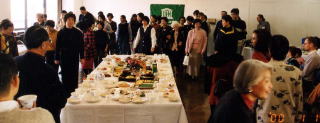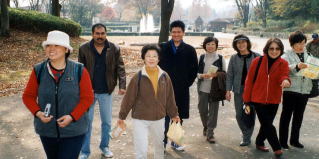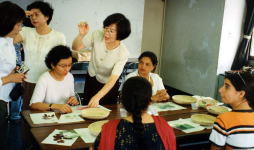No.183
Introduction of Committee's Activities -Part 3-
International Exchange Committee
|
 The Meguro UNESCO Association has been making friends with many people
since its foundation. They have taught us many things, and we have shared
what we have with them, too. The International Exchange Committee sometimes
works alone, and sometimes with other committees. The International Exchange
Bazaar, the Art
The Meguro UNESCO Association has been making friends with many people
since its foundation. They have taught us many things, and we have shared
what we have with them, too. The International Exchange Committee sometimes
works alone, and sometimes with other committees. The International Exchange
Bazaar, the Art  Exhibition, and the International Exchange Forum are some of the activities
carried out with other committees. The venues of those events become places
where people meet and communicate. As for our independent activities,
we have made excursions with friendship members; Forest Park was one of
the places we visited. We've also had classes for chigiri-e (picture pasted
with Japanese paper torn into pieces) and sumi-e (brush and India ink drawing). Any
member can take part in these programs. So please read Short News attentively.
Exhibition, and the International Exchange Forum are some of the activities
carried out with other committees. The venues of those events become places
where people meet and communicate. As for our independent activities,
we have made excursions with friendship members; Forest Park was one of
the places we visited. We've also had classes for chigiri-e (picture pasted
with Japanese paper torn into pieces) and sumi-e (brush and India ink drawing). Any
member can take part in these programs. So please read Short News attentively. On February 23 (Sat.) from 2:00 p.m. "Enjoy Noh Theater", organized
by the International Exchange Forum, is to  be held. The members of the Kita school, in order to introduce Japanese
culture, kindly offered us their Noh theater, Kita Roppeita Kinen Nohgakudo
(7 minutes' walk from Meguro Station, next to Sugino Gymnasium). "Hagoromo"
(The Robe of Feathers) performed by Akio Shiotsu, bearer of the title "Important
Intangible Cultural Property", is a Noh dance that you should not
miss. We do hope you will be able to come. It will be a good opportunity
for people from other countries, especially young people including Japanese
youths to get to know one of Japanese traditional cultures. We'd be happy
if you could bring many of your friends. (Please read the article bellow
by Akio Shiotsu)
be held. The members of the Kita school, in order to introduce Japanese
culture, kindly offered us their Noh theater, Kita Roppeita Kinen Nohgakudo
(7 minutes' walk from Meguro Station, next to Sugino Gymnasium). "Hagoromo"
(The Robe of Feathers) performed by Akio Shiotsu, bearer of the title "Important
Intangible Cultural Property", is a Noh dance that you should not
miss. We do hope you will be able to come. It will be a good opportunity
for people from other countries, especially young people including Japanese
youths to get to know one of Japanese traditional cultures. We'd be happy
if you could bring many of your friends. (Please read the article bellow
by Akio Shiotsu)
Chairperson of the International Exchange Committee: Fumiko Miyazaki
Vice chairpersons: Kimiko Shibutani, Sadako Harada, Shizue Suzuki
Photos (top) New Year's Party (middle) Forest Park was so large we were
afraid of getting lost (bottom) Chigiri-e class
Join Us with Your Determined Will to See By Akio Shiotsu
Many people somehow seem to think that Noh plays are "hard to understand"
or "boring", even though they have never seen one.
The Noh stage projects into the audience seating area. It is because
Noh is not a play merely to show the audience but an art that has quite
a large element of being created by both the performers and the audience. It
eliminates unnecessary things in the extreme. A single pine tree symbolizes
the seashore dotted with pines called Miho-no-Matsubara, and plovers or
seagulls floating on the waves are just suggested when the performer points
his folding fan toward where they are supposed to be. There is no ornament
in the shape of a plover or a seagull. Each spectator pictures in his
mind Miho-no-Matsubara, plovers or seagulls, and creates his own stage.
He is free to imagine an illusory pine-dotted seashore wrapped in a morning
mist or a pine-dotted shore lit up with the crimson setting sun. If the
performer is good, the spectators will have a vivid picture of the sight,
and it is every performer's ideal to develop his ability to that level. The
greatest source of that ability is the force of will. Even when he is
standing still, the energy burning inside the performer is enormous. And
it depends largely on the audience whether that energy will be fruitful
or wasted. It seems that only when the spectators' will to see and the
performers' willpower interact, something moving can be produced. The
energy condensed in the performers' souls is the core of Noh, and it gives
life to those Noh masks, making them look as if they are smiling. That
is the very difficult part of Noh, and also that is where its beauty comes
from.
Our performance will last only less than an hour, the blink of an eye
in our long life. I'd like you to be determined to see and try to watch
the stage as intently as possible, and feel at least something from Noh,
one of
Japan's proudest traditional arts.